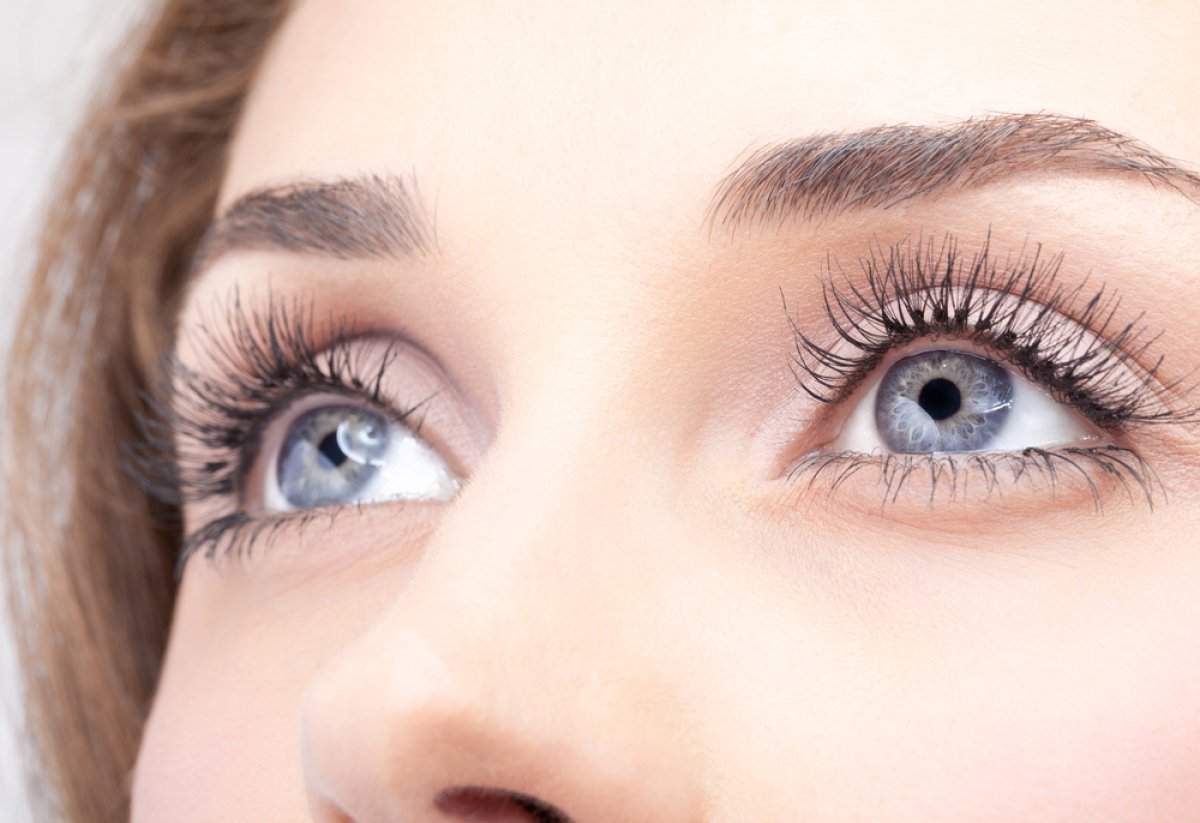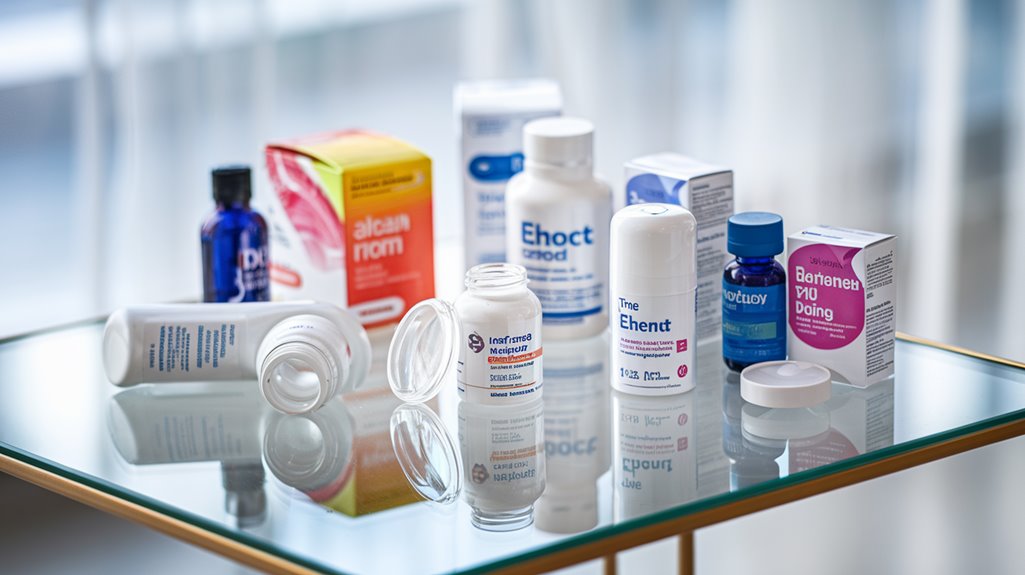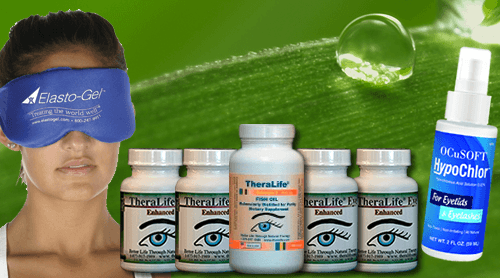To address watery eyes, TheraLife offers an array of natural supplements and holistic solutions that enhance eye health and alleviate discomfort. Their products are designed to work at the cellular level, promoting overall ocular wellness and targeting conditions like blepharitis, dry eyes, and uveitis. Unlike conventional antihistamines, TheraLife’s offerings focus on natural ingredients that minimize side effects and support long-term relief. By adhering to natural remedies and personalized care plans, customers can optimize eye health while navigating potential side effects. TheraLife’s products are rooted in comprehensive research, providing a safer and more sustainable approach to eye care.
Powerful Treatment To Stop Watery Eyes – TheraLIfe
Root cause of watery eyes is chronic dry eyes. Treat chronic dry eyes with oral treatment from TheraLIfe.
Add To CartKey Takeaways
- Fexofenadine effectively manages eye symptoms and nasal congestion, providing quick relief from watery eyes.
- Ketotifen eye drops serve as antihistamines and mast cell stabilizers, reducing symptoms like watery eyes.
- Loratadine offers 24-hour relief from allergy symptoms, including watery eyes, with minimal drowsiness.
- Patanol eye drops, used twice daily, alleviate watery eyes by combining antihistamine and soothing properties.
- Second-generation antihistamines reduce watery eyes with low sedation, suitable for daytime use.
Oral Antihistamines Options
When choosing oral antihistamines for watery eyes, it’s essential to contemplate options that offer effective relief with minimal side effects. Consider Loratadine, Fexofenadine, and Levocetirizine, each providing 24-hour relief with reduced sedation. Loratadine and Fexofenadine are commonly dosed at 10 mg daily, while Levocetirizine is typically taken at 5 mg. These medications are generally safe, but it’s important to adhere to dosage guidelines to minimize side effects like headache and dry mouth. For those who experience sensitivity to environmental factors, using protective eyewear alongside antihistamines can significantly reduce exposure to irritants like pollen and dust. Watery eyes, or epiphora, can also result from irritants causing overproduction of tears, which these antihistamines can help manage. Be aware of serious yet rare allergic reactions. Consult a healthcare provider, especially if you have liver or kidney disease, as dosage adjustments might be necessary. Monitoring for any drowsiness or worsening dry eye symptoms guarantees the safest use of these oral antihistamines.
Antihistamine Eye Drops Guide
When choosing antihistamine eye drops for watery eyes, consider both the ingredients and their therapeutic benefits; for instance, ketotifen offers dual action as an antihistamine and mast cell stabilizer. Dosage varies, with Zaditor and Alaway recommended at one drop every 8 to 12 hours, while Patanol requires application twice daily. Chronic dry eyes can result from autoimmune diseases, menopause, and certain medications, making it important to address underlying conditions. Be aware of potential side effects such as mild burning or blurred vision, and always follow usage guidelines to mitigate risks. Many antihistamine eye drops are safe for children 3 years and older, making them a versatile choice for families dealing with allergies.
Ingredients and Benefits
To effectively manage allergic conjunctivitis, understanding the ingredients and benefits of antihistamine eye drops is essential. The synergy of ingredients like antihistamines and mast cell stabilizers targets allergy triggers, providing extensive relief. Antihistamines block histamine release, reducing itching and swelling, while mast cell stabilizers prevent further histamine release, ensuring long-term management. Naphazoline HCl acts as a redness reliever, and Pheniramine Maleate enhances antihistamine effects. Ophthalmic lubricants, such as glycerin and carboxymethylcellulose, lock in moisture, soothing irritation. Using these drops regularly can maximize their effectiveness and help prevent symptoms from worsening. The quick relief from itchy, watery eyes combined with low side effects makes these drops effective against allergens like pollen and dander. Opt for combination drops to address both immediate symptoms and prevent future allergic reactions efficiently. Additionally, maintaining proper tear film balance is crucial to prevent dry eye symptoms, which can exacerbate eye discomfort during allergy season.
Usage and Frequency
Although managing allergic conjunctivitis effectively requires precise adherence to usage guidelines, antihistamine eye drops typically offer relief when used correctly.
Administer these drops to affected eyes twice daily, maintaining an interval of 8 to 12 hours. Many allergy medications, including antihistamine eye drops, are available over-the-counter. Strictly follow the product’s instructions or your healthcare provider’s frequency recommendations to maximize efficacy and prevent overuse.
Prioritize hygiene by washing your hands and avoiding contact with the dropper tip to prevent contamination. If you wear contact lenses, remove them before application and wait at least 10 minutes to reinsert. It is also essential to address environmental irritants that may exacerbate eye symptoms, such as dust or smoke.
For extended use, consult a healthcare professional to ascertain safety. Tailor the frequency of application based on symptom severity, and consider using refrigerated artificial tears to minimize discomfort.
Potential Side Effects
Despite their effectiveness in alleviating symptoms of allergic conjunctivitis, antihistamine eye drops can lead to several side effects that users must be aware of. It’s a common misconception that these drops are free from adverse effects. You might experience temporary burning, stinging, or increased dryness. Blurred vision and sensitivity to light aren’t uncommon. Long-term use can exacerbate dry eyes, potentially worsening symptoms. To manage these side effects, use the drops as prescribed and monitor for persistent issues like eye pain or severe vision problems. Dry eye disease incurs substantial healthcare costs and impacts quality of life, so it’s important to address any worsening of symptoms promptly. If symptoms persist after several days of using over-the-counter eye drops, it is advisable to see a doctor for further evaluation and treatment options. If you notice any serious allergic reactions like swelling or trouble breathing, seek medical attention immediately. Proper side effect management facilitates safe use, preventing complications from misuse or overuse.
Understanding Second and Third Generation
When choosing between second and third-generation antihistamines for watery eyes, understanding their pharmacological distinctions is essential. Loratadine and fexofenadine, both second-generation options, offer minimal sedation and sustained 24-hour efficacy, making them ideal for daytime use. Third-generation antihistamines like levocetirizine provide enhanced symptom relief with reduced drowsiness, as evidenced by comparative studies highlighting their superior potency and anti-inflammatory properties. Unlike first-generation antihistamines, second-generation options do not cross the blood-brain barrier, resulting in fewer sedative effects and making them preferable for those needing to maintain alertness during daily activities. For those experiencing excessive tearing due to chronic dry eyes, balancing tear production may be helpful.
Antihistamine Generations Explained
Understanding the distinctions between second and third-generation antihistamines is essential for effective allergy management. Antihistamine classifications highlight generation differences, primarily focusing on safety and duration. Second-generation antihistamines, like loratadine and cetirizine, exhibit less sedative effects and longer action, lasting up to 24 hours. They’re preferred for daytime use due to minimal interaction with the central nervous system, reducing drowsiness and side effects. They are commonly used for conditions like hay fever and allergic rhinitis. Third-generation antihistamines are derivatives of the second-generation, designed to enhance efficacy and reduce potential side effects further. They maintain the benefits of their predecessors while offering improved safety profiles, particularly concerning cardiac risks. Both generations provide effective relief from allergy symptoms, with fewer side effects than their first-generation counterparts, making them suitable for long-term use. Additionally, TheraLife Eye capsules are a natural alternative that targets the root cause of dry eyes, providing relief from inflammation and dryness symptoms.
Comparing Loratadine and Fexofenadine
Both loratadine and fexofenadine, key players in the domain of second-generation antihistamines, offer effective relief from allergy symptoms like sneezing and itchy eyes within 1-3 hours. While both are effective in alleviating seasonal allergies, fexofenadine has shown superior efficacy in managing eye symptoms and nasal congestion, as well as enhancing quality of life for individuals with allergic rhinitis. Administered once daily, both maintain their effectiveness for a full 24 hours. Fexofenadine may provide quicker symptom relief, often within 1 hour, and is noted for its potency in blocking histamine, alleviating sneezing and runny nose. Dry eye disease can significantly impact quality of life, making effective allergy management crucial for those who experience both conditions. Here’s a quick comparison:
| Aspect | Loratadine | Fexofenadine |
|---|---|---|
| Time to Relief | 1-3 hours | 1-3 hours |
| Comparative Efficacy | Moderate | Superior |
| Quality of Life Impact | Standard | Markedly Better |
When choosing between the two, consider individual responses and specific symptom relief needs.
Minimal Drowsiness Benefits
While choosing an antihistamine, it’s essential to evaluate the minimal drowsiness benefits offered by second-generation options. These medications, like Allegra (fexofenadine) and Claritin (loratadine), are specifically crafted for minimal sedation effects, making them ideal for allergy management strategies. In fact, studies have shown that these second-generation antihistamines exhibit low sedation rates, supporting their use as nonsedating options. Unlike first-generation antihistamines, second-generation options exhibit a reduced ability to cross the blood-brain barrier, considerably decreasing the risk of drowsiness. Allegra is particularly remarkable for its negligible sedative effects, making it a preferred choice for individuals in safety-sensitive occupations. Additionally, the long-lasting nature of these medications, often providing relief for up to 24 hours, supports consistent allergy symptom management without frequent dosing. It’s important to note that dry eye disease can be exacerbated by certain medications, so patients should discuss their symptoms with healthcare providers. Always consider patient-specific factors when selecting the best antihistamine for effective, minimal drowsiness relief.
Eye Drops Usage Tips
Before applying eye drops, consider refrigerating them, as the cool sensation can help guarantee you’ve successfully administered the dose. Use your dominant hand for precise eye drop techniques, enhancing accuracy. Maintain sterility by washing hands and avoiding contact with the dropper tip. Eye drop storage is essential; refrigerate when possible and keep the cap clean. To minimize wastage, use only one drop per application. Post-application, close your eyes and apply pressure to the inner eyelid corners, reducing systemic absorption risk. It is important to recognize the role of puncta in tear drainage when applying eye drops. For those seeking lasting dry eye relief, consider oral formulations that address the root causes of dryness. Follow prescribed dosage and wait five minutes before reapplying.
| Technique | Purpose | Key Tip |
|---|---|---|
| Mirror Technique | Accurate drop placement | Use non-dominant hand |
| Lying Down | Steady application | Rest bottle on nose bridge |
| Inner Corner | Efficient distribution | Blink to spread drop |
| Tilt and Aim | Direct delivery | Create eyelid “pocket” |
Identifying Causes and Symptoms
When considering the causes of watery eyes, it’s vital to understand the underlying factors and related symptoms that might require medical attention.
A thorough causes overview includes dry eye syndrome, eye infections like conjunctivitis, allergies, and structural eyelid issues such as ectropion or entropion. Blocked tear ducts are also common, especially in infants and seniors.
Symptom identification is important, with constant tearing, sticky eyes, blurred vision, irritated eyelids, and itchy eyes as primary indicators.
Diagnostic approaches include consulting with an oculoplastic ophthalmologist, examining eyelids, evaluating tear drainage, and utilizing diagnostic tests. Accurate diagnosis guarantees targeted treatment.
Recognizing these symptoms early can guide you in seeking appropriate care and potentially using antihistamines to alleviate discomfort effectively.
Managing Side Effects and Precautions
To effectively treat watery eyes with antihistamines, it’s important to take into account potential side effects and necessary precautions.
Drowsiness, dry mouth, and constipation are common side effects, especially with first-generation H1 antihistamines. Side effects management includes staying hydrated and increasing dietary fiber.
In elderly patients, there’s a higher risk of falls and confusion, necessitating elderly precautions. Always consult a healthcare professional before starting treatment, particularly for long-term use.
Opt for second-generation H1 antihistamines to minimize side effects. Monitor for serious issues like glaucoma and urinary retention.
Be cautious of medication interactions, especially with cimetidine. Avoid overdose to prevent toxicity.
Powerful Treatment To Stop Watery Eyes – TheraLIfe
Root cause of watery eyes is chronic dry eyes. Treat chronic dry eyes with oral treatment from TheraLIfe.
Add To CartFrequently Asked Questions
Can Antihistamines Be Used for Non-Allergic Watery Eyes?
You might wonder if antihistamines can help with non-allergic watery eyes.
Generally, antihistamines are less effective for non-allergic causes compared to allergic ones. Oral antihistamines often won’t provide significant relief, while nasal antihistamines like azelastine may offer some benefit.
However, their effectiveness varies, and regular usage is essential. If you try them, follow recommended dosages, and be aware that side effects like drowsiness could occur, impacting daily activities.
How Do Antihistamines Affect Contact Lens Wearers?
When you’re a contact lens wearer, antihistamines can greatly impact your routine. They often lead to eye irritation and dryness, so manage contact lens care meticulously.
Always remove lenses before applying drops like Pataday, waiting 10-15 minutes before reinserting. Evidence shows that preservative-free options such as Zaditor minimize irritation.
Dosage adherence is vital; overuse leads to dryness, exacerbating discomfort. Regular lens cleaning and replacement are essential for maintaining eye health.
Are Natural Alternatives Effective for Watery Eyes?
Ironically, while you search for chemical solutions, natural remedies like herbal supplements offer relief for watery eyes.
Dosage matters; for example, omega-3 fatty acids, 1000 mg daily, enhance tear film quality.
Evidence supports using cooled chamomile tea bags, applied for 15 minutes, to reduce irritation.
Rose water, a few drops on cotton pads, can alleviate redness.
These remedies, grounded in tradition, provide effective alternatives to pharmaceuticals, reducing dependency on synthetic solutions.
Can Diet Changes Help Reduce Watery Eyes?
You can reduce watery eyes by making dietary adjustments.
Focus on foods rich in omega-3 fatty acids, vitamins C and E, and zinc. Investigate food sensitivities which might trigger symptoms.
Evidence suggests a regular intake of fatty fish, nuts, leafy greens, and citrus fruits aids in managing eye irritation.
Guarantee proper hydration and consider supplements like omega-3, especially if dietary sources are insufficient.
Regularly incorporating these nutrients supports overall eye health.
Do Antihistamines Interact With Other Medications?
You need to be vigilant about antihistamine interactions to guarantee medication safety.
Antihistamines can interact with antidepressants, blood pressure medications, and other antihistamines, potentially increasing side effects like drowsiness and decreased coordination.
It’s vital to manage doses carefully and consult healthcare professionals. Evidence shows that interactions may worsen conditions like glaucoma.
Use precise dosages and avoid combining multiple antihistamines to mitigate risks. Always check for potential interactions before starting any new medication.
Powerful Treatment To Stop Watery Eyes – TheraLIfe
Root cause of watery eyes is chronic dry eyes. Treat chronic dry eyes with oral treatment from TheraLIfe.
Add To CartConclusion
To effectively manage watery eyes and alleviate discomfort, consider exploring TheraLife’s range of natural eye care products. TheraLife offers a holistic approach to eye health, emphasizing the use of their products that are designed to provide relief from various eye conditions such as blepharitis, dry eyes, and uveitis. By integrating evidence-based natural ingredients, TheraLife’s solutions focus on addressing the root causes of eye issues rather than just masking symptoms.
TheraLife products, such as their specialized supplements, work from the inside to promote eye health and reduce inflammation, offering an alternative to traditional antihistamines and eye drops. Their comprehensive approach includes dietary recommendations and lifestyle changes to support optimal eye function.
Customers benefit from TheraLife’s commitment to safety, efficacy, and personalized care. By consulting with healthcare professionals and following TheraLife’s guidelines, users can achieve maximum relief and comfort. The brand emphasizes the importance of understanding the causes and symptoms of eye conditions, ensuring that customers can make informed decisions about their eye care regimen.
Stay informed about the latest developments in eye care, follow TheraLife’s recommendations, and experience soothing relief from watery eyes through their natural and holistic solutions. Prioritize your eye health with TheraLife’s dedicated range of products and achieve a balance that maximizes efficacy while minimizing discomfort.





